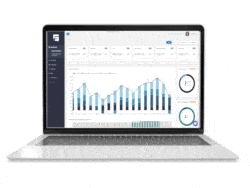QuickBooks is the preferred accounting software for most small to mid-sized commercial real estate businesses in the U.S for many good reasons. Efficient, comprehensive, and affordable, it streamlines processes from payroll to taxes, making it an invaluable tool for experienced accountants and new business owners alike.
But even new business owners know that commercial real estate has additional accounting and management needs. Some, like handling leases, can be quite complex. How can you leverage QuickBooks to help you with all of your commercial property needs?
In this article, we’ll discuss why integrating with QuickBooks is a good option for commercial real estate businesses and where it requires extra help. We’ll also discover how you can use QuickBooks to effectively assist you in property management tasks like handling leases.
This is part 1 of a 4-part series that aims to help you leverage QuickBooks and commercial property management software to meet your business goals. Keep an eye out for parts 2, 3, and 4 on our blog for more commercial real estate insights.
Advantages of QuickBooks for Commercial Real Estate
As mentioned above, QuickBooks is a strong choice for any small to mid-size business, including in commercial real estate. It offers a full, reliable set of accounting tools that allows you to keep your data together, rather than spreading it out across many spreadsheets.
Owned by Intuit, it also employs experienced accounting and tax advisors to help you make the smartest decisions for your business. It also features automations and a scalable design to remain useful as your business grows.
Drawbacks of QuickBooks for Commercial Real Estate
Despite its many benefits, QuickBooks is not designed specifically for commercial real estate. This means that it isn’t always equipped to handle very specific processes or types of transactions that commercial real estate owners encounter regularly. While some businesses create workarounds, there are certain tasks that require extra support.
A major example is property management. Since QuickBooks focuses on accounting, it isn’t built to do things like handle maintenance requests or leases. This can be a challenge for commercial real estate owners because good lease management requires good accounting.
You must properly negotiate and track elements like common area maintenance (CAM) charges and caps, along with lease escalations. Then, each year, you must perform CAM reconciliation to ensure everyone pays their fair share of collective expenses. It’s important to record this data properly as income and expenses, a difficult task when property management systems are fully separate from your QuickBooks accounting setup.
What is the Best Strategy for Handling CRE Leases in QuickBooks?
So how do you effectively manage commercial real estate leases using QuickBooks? The solution isn’t switching between lots of different programs to handle different tasks, and it isn’t giving up on the advantages of QuickBooks. Instead, take control of all your tasks with integrated commercial property management software.
Benefits of Commercial Property Management Software
Commercial property management software like STRATAFOLIO is built to help you take care of the processes QuickBooks doesn’t cover. A good software is an all-in-one platform that prevents you from needing to buy lots of extra tools and add-ons. Instead, keep your entire workload in one place.
Not every property management software offers the same features. When choosing the right one for your business, look for one like STRATAFOLIO that specializes in commercial real estate. Especially useful features to seek out include:
- Commercial lease management tools
- QuickBooks integration
- Certificate of Insurance (COI) tracking
- Tenant portals for ACH rent payments, maintenance requests, and more
- Automations for complex processes like CAM reconciliation
- Notifications for key dates including lease renewals and escalations
- Customizable, shareable reports for owners and investors that include property-level and portfolio-wide details
How Integrated Software Helps You Manage Leases
Commercial property management software like STRATAFOLIO integrates directly with QuickBooks, meaning that all your financial data syncs automatically between both programs.
Easily reference lease details, rent income, CAM charges and more where you need it, when you need it, and never worry about losing data between separate systems again. Integrated software allows you to link your lease management and accounting systems. This gives you full visibility and clarity over your entire portfolio. Handle lease escalations, CAM reconciliation, and reporting with confidence. With integrated software, you can stay informed about your leases and be prepared to take growth opportunities.
Empower Your Business with QuickBooks and STRATAFOLIO
Ready to take charge of your leases? Due to a complete, two-way integration with both QuickBooks Desktop and Online, STRATAFOLIO may be the best commercial property management software option for your leasing needs.
STRATAFOLIO is designed knowing that property management and accounting aren’t two separate things. They work together to create a successful business. Take advantage of automations, synced data, and customizable reports to unify and streamline your workflows.
To find out how STRATAFOLIO’s lease management and accounting tools can work for you, schedule a free 1:1 demo now.






